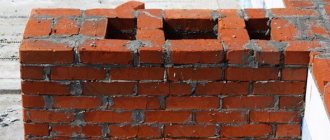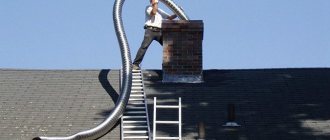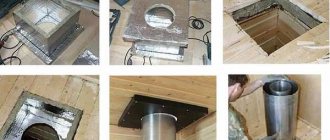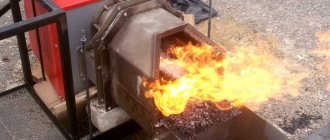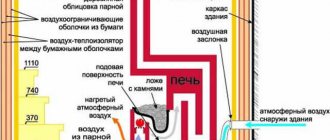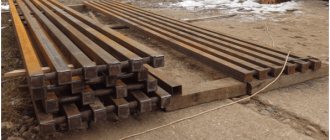The proper functioning of the fireplace depends not only on the installation of the firebox, but also on the competent design and installation of the chimney. Everything is important: from calculations of the pipe cross-section to the nuances of thermal insulation. Only a high-quality chimney will best suit its purpose.
Do you want to build a chimney duct, but don’t know which pipe to choose and how to install it? We will help you deal with this problem - in the article we looked in detail at how to make a chimney for a fireplace, paying attention to the pros and cons of pipes made of various materials.
They also provided important requirements for arranging fireplaces and drawing up a project. The article material was supplemented with detailed instructions for installing a chimney, providing it with step-by-step photos.
How to install the most fire-hazardous section of the chimney
When installing an amber stove through a wall, sandwich systems are installed with your own hands. The first segment of the chimney is made from a fragment of a smaller pipe. It is fixed in such a way as to prevent overheating of the fasteners; for this it is necessary to retreat a sufficient distance. Basalt insulation is laid from the 2nd bend.
The first segment of the chimney is made from a fragment of a smaller pipe.
Safety regulations
Do not forget that the chimney is a source of danger. Place the flue away from the cable and gas pipe. Contact with other utilities is undesirable. The maximum length of individual fragments is 1 meter
It is important to follow building codes and regulations
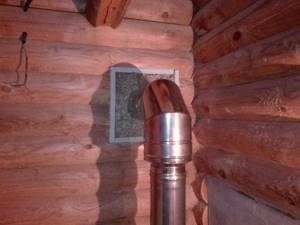
Place the flue away from the cable and gas pipe.
Choosing the material and design of the chimney pipe
The design of the chimney pipe is directly related to the type of stove for heating the room. So, for a stone Russian stove, a brick structure is most organically suitable, which rests on the stove itself, or is built on its own foundation. In multi-storey buildings of the last century, chimney ducts were installed in the thickness of the walls.
Similar chimneys are usually equipped with all types of stone stoves and fireplaces. Installation of brick chimneys should ensure the smoothest possible surface of the internal channel and ideal verticality of the masonry.
As a compromise, in recent years old brick chimneys have been "sleeved" - a steel pipe inserted into the brick chimney. This was necessary to reduce the cost and, accordingly, the amount of materials for a stone chimney, the installation of which could be more expensive than the rest of the stove structure.
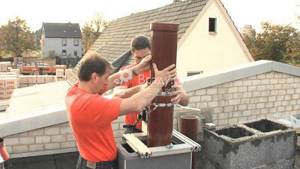
In more modern and technologically advanced metal furnaces, steel or ceramic-composite pipes are usually used. A metal chimney is much cheaper than a brick pipe and much easier to install. However, under the influence of the condensate that appears, the metal actively corrodes and collapses. In addition, at the junctions of individual sections it is difficult to ensure perfect tightness and smoke can leak into the room.
Ceramic chimney pipes are more reliable. But, unlike steel ones, they have significant weight, require reinforced fastening, and are comparable in cost to brick ones. The new design systems, called sandwich chimneys, do not have all these disadvantages.
Choosing material for constructing a chimney
Currently, most chimneys are built on the basis of a metal pipe made of stainless or galvanized steel. Occasionally, structures based on brickwork are found, mainly in old houses.
In new residential buildings, brick chimneys are just an imitation of masonry: they are based on the same metal pipe, simply lined with brick on the outside.
If owners want to get an authentic brick chimney, they need to choose a special type of material.
It is important! For contact with hot air, smoke and exhaust gases, you need a special refractory brick that can withstand temperatures up to 700 degrees.
In addition to metal, ceramic and glass chimneys are also used. Ceramics have a long service life - from 30 years and above, but the cost of such a design is several times higher. Glass chimneys are also an expensive option, usually found in designer fireplaces.
We recommend that you read: How to correctly make the transition from a brick chimney to a sandwich?
Most home or cottage owners prefer a stainless steel metal pipe when installing a fireplace. This material is more affordable, is resistant to corrosion and high temperatures, is lightweight and easy to install.
Varieties and materials
Pipes for fireplaces come in the following types:
made of brick;
metal;
monolithic or multilayer;
decorative or the most simple ones.
But in fact, it doesn’t matter: what shape, what material, whether they are prefabricated systems or not - nothing really matters
One thing is important - adequate ventilation of the firebox. And based on these considerations, only that pipe is good for a chimney, which ensures that the room with the fireplace does not smell of smoke and that the wood ignites from the very first match
If you are planning to install a fireplace with a chimney, then at a minimum you should know something about the materials from which chimneys are installed.
Ceramic
These are chimneys that are resistant to relatively high temperatures. They have great heat capacity and durability, but they cost a lot. A ceramic chimney is usually a three-layer structure with a ceramic inner pipe (fireproof), a heat insulator and a concrete shell. Thermal insulators are non-flammable mineral wool, and the concrete shell contains channels that reduce the temperature of the outer surface and provide additional heat removal.
Steel
A steel chimney is a round pipe, made of stainless steel or galvanized, with insulation and an insulated contour on the outside. The steel kit is quite easy to install and weighs very little. Metal pipes are increasingly becoming fashionable today, and to connect a stove or fireplace to a chimney, they very often use products made of black steel, because with them there will be no condensation at the fire source and the pipe will not corrode.
Ordinary metal cannot act as the main chimney riser. Inserts and open connection components are most often enameled steel sectional pipes, the metal thickness of which is at least 0.5 mm. This is due to their corrosion and acid resistance and are designed for temperatures of 450C, and for a short time - at 750C. As a rule, this is enough.
Stainless steel
The cost of a metal chimney made of stainless steel will be higher, but its service life will be longer. In addition, this design can withstand much higher temperatures (up to 1200C).
If these are domestic heating sources, then the thickness of the steel is used in the range of 0.5-0.8 mm, sometimes 1 mm. At the same time, easy installation of the entire structure, its low weight and immunity to acids are of great importance.
The highest chemical aggressiveness of the emission occurs when liquid fuel is burned. Here it is worth mentioning modular chimneys for metal fireplaces, which can be single or double, insulated. They can be laid openly, without fear that the structure may catch fire or, even worse, burn.
It must be said that visually such pipes look quite aesthetically pleasing, do not require brickwork, and do not require a foundation. The double chimney with insulation is suitable for installation both indoors and outdoors.
Combined
A variant of combined insulated chimneys made of metal is also possible, when the inner part is acid-resistant stainless steel from 0.8 to 1 mm, and the outer part is thinner and enameled.
Sandwich
Stainless steel sandwich pipes require special attention.
This is, first of all, durability, excellent traction due to the smoothness of the inner surface and minimal soot deposition.
At first glance, it is expensive, but it is unlikely that a brick structure, and even taking into account the foundation, mortar for masonry and payment for all the work, will be cheaper.
Coaxial
This is a chimney of a double-circuit design, having pipes of different diameters and the narrower of them is located inside the wider one. To prevent the pipes from touching, jumpers are provided.
Attached chimney
The safest solution may be to install a fireplace with an attached chimney. In this case, there will be no combustion products in the living space even if the masonry becomes leaky. And such a smoke removal system is installed not necessarily simultaneously with the construction of the house itself, but at any convenient time.
In this case, a device in the form of a tee with an inspection channel and a condensate collector is connected to the chimney.
External placement
A pipe with external placement increases the area of a small room. The chimney for the fireplace here is led through the wall near the heating device directly to the street.
Oval chimney
The draft force in it will depend on the cross-sectional shape of the chimney. The most aerodynamic are round tubes. Square pipes are better than rectangular ones, and an oval chimney is completely rare; it is used only when lining a rectangular brick channel.
No. 2. Chimney made of steel pipe
For gas and solid fuel boilers , steel pipes are best suited, but at the same time it must be stainless, heat-resistant and acid-resistant , since sulfur particles, which are found in almost every type of fuel in one quantity or another, when combined with moisture and coal particles form aggressive environment. Stainless steel can withstand temperatures up to 5000C ; pipes with a wall thickness of 0.6 mm are used to construct chimneys, but for solid fuel boilers it is better to use steel with a thickness of 1 mm. Steel pipes are a whole system of straight sections and various shaped elements, incl. adapters, bends, tees, etc. Such a system can be installed independently or built into an existing brick channel.

The main advantages of steel pipes:
- simplicity and high speed of installation, because the weight of the structure is small, there is no need for a foundation, and even not the greatest professional can assemble the entire system from ready-made elements without any problems;
- repair work is easy to carry out;
- soot particles do not accumulate on smooth walls, their surface is easy to clean, so we can talk about consistently high aerodynamic characteristics for the passage of exhaust gases;
- high corrosion resistance;
- the ability to create complex structures;
- high tightness, due to which you can create forced exhaust.
Among the disadvantages is the high cost, especially when compared with a brick or ceramic analogue, but if simplicity and speed of installation, light weight and resistance to aggressive environments are important, then it is better to choose a steel chimney. Disadvantages sometimes include low heat resistance, but for modern boilers with a slow combustion system, greater heat resistance is unnecessary.
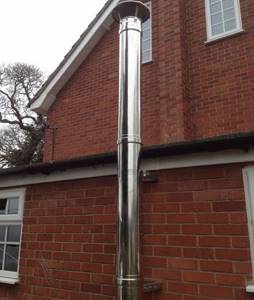
Depending on the characteristics of the room, boiler and climate, one of the following types of steel chimneys is used:
- single wall steel pipe , consisting of one layer of stainless steel. This is the simplest and cheapest option; such a chimney is laid in a specially laid vertical channel. Often such chimneys are installed in a bathhouse, and the heat released from the steel pipe is used to heat water;
- single-wall steel pipes for reconstruction of a brick chimney may have an oval shape. Such a restoration process and adaptation of an existing chimney to work with a gas boiler is called “linering”;

- double wall sandwich panels, consisting of two steel pipes, in the space between which a layer of insulation (basalt wool) is placed. Using the latter allows you to prevent the formation of condensation inside the pipe, while its outer surface hardly heats up. Ease of assembly and excellent performance allow such systems to be used both indoors and outdoors on the wall;
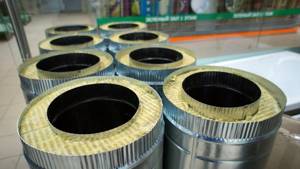
- coaxial chimneys made of steel also consist of two pipes placed one inside the other, only there is no insulation between them, and the resulting space is intended to supply air to the boiler to support combustion. Combustion products are discharged through the inner pipe. Such chimneys do not behave very well in harsh domestic winters. Cold outside air passing through the outer pipe can sometimes greatly cool the inner pipe and the gases flowing through it. This leads to a sudden drop of condensate and its freezing on the surface of the pipe. The chimney gradually becomes clogged, and the automation, reacting to this, turns off the boiler, so in this case it is better to equip chimneys with two separate pipes.
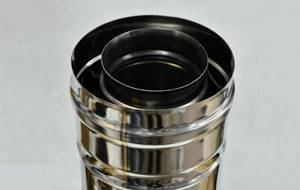
It is worth noting that sometimes thick pipes made of low-alloy steel are used to construct a chimney - this option is usually found in sauna stoves. Also, craftsmen sometimes use cast iron sewer pipes for the same purposes.
Construction of a ceramic smoke channel
The most reliable and safe option for installing a chimney in a wooden house is a construction made of ceramic blocks. Its outer side practically does not heat up, which means there will be no problems with passage through the ceilings.
Let's consider the sequence of assembling a smoke channel from components of the German brand Schiedel Rondo Plus:
Let’s immediately make a reservation that the main one is constructed from ceramic modules, i.e. a separate pipe for which a separate foundation is arranged.
All technological holes are cut out along the construction site. Cutting is done with a regular grinder with a diamond blade.
To make geometrically accurate holes, the ceramic chimney kit includes a template. Further:
The ceramic chimney is assembled in a standard manner: modules are built up one after another
However, it is worth paying attention to the specifics of passages through the attic floor and through the roof
In our example, the chimney and ventilation riser are located next to each other, which is why we had to slightly trim the rafters:
We also have another article on our website containing step-by-step instructions on how to build a ceramic chimney, attach it and decorate the outside.
How to position the smoke channel correctly
Chimneys according to the type of location are divided into:
- mounted - installed above the heating device and are actually its vertical extension;
- free-standing (radical) - the smoke channel is located vertically on the side of the unit, a separate foundation is built for it;
- wall ducts - the chimney is designed in the wall of the house.
The chimney can be brought out through the wall; this can be done even in an already constructed building
In relation to the building, the location of the chimney can be as follows:
- External. Its advantages: ease of installation both in a new house and in a previously built one; service availability.
Disadvantages of an external location: the chimney requires mandatory insulation, organizing the tightness of the passage through the wall. It is quite difficult to give an aesthetic appearance to a chimney when it is located externally; its rise above the level of wind pressure is inevitable.
- Internal. Advantages: the internal arrangement provides good draft, the chimney can be in the most vertical position.
Disadvantages of the internal location: additional work when passing the smoke duct through the interfloor and roof ceilings, very careful compliance with fire safety measures in these areas. Such a chimney will also occupy useful space in the room.
Installation
Installation of structures is always considered on an individual basis. This is the most critical stage; to install a chimney for a fireplace with your own hands, you need to calculate its diameter and location.
A suitable place to place a fireplace chimney is near the ridge of the roof. This will make the protruding part of the pipe smaller.
The height must be at least 4 meters. Calculation of maximum values depends on your building.
Calculation of the diameter of the pipe will also be required to ensure that the structure passes all the floors without difficulty.
Particular attention is always paid to the installation of equipment in wooden buildings. Such buildings are most susceptible to fires
In order to avoid this, it is necessary to use a transition pipe, which will not only protect against fires, but will also provide high-quality insulation between the roof and the fireplace chimney.
In order to make a hole in the roof, you must remember that its size should be slightly larger than the diameter of the pipe.
In addition, you need to pay attention to possible joints. They can not only reduce the efficiency of the heating device, but also worsen safety parameters
In addition, the service life will be noticeably reduced.
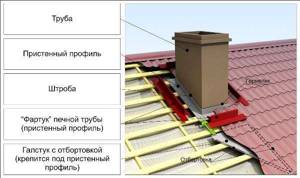
Sectional view of a chimney pipe on the roof
The most difficult part of the installation is considered to be the point where it passes through the roof.
The main parameters that you need to pay attention to are quality and safety.
For each design there is a basic set of requirements that need to be addressed
Diagram of the relationship between the type of heating device, the temperature in the chimney and the material of its manufacture
For example, for a brick building, the work scheme looks like this:
- Foundation.
- Solution.
- Masonry.
- Mopping.
- Header.
- Dymnik.
For a ceramic device, the work flow is as follows:
- foundation,
- Fastening modular elements.
The construction and installation of chimneys for fireplaces is carried out taking into account the expansion of the material under the influence of heat. In addition, it is necessary to take care of the tightness of the equipment during operation.
A properly equipped chimney will last a long time.
What to consider when choosing a material for a chimney?
A chimney is a complex structure consisting of a vertical pipe, an umbrella for protection from precipitation, an inspection window for maintenance, a tray for collecting condensate and other elements. The vertical pipe is considered the main part of the chimney, and the safety and efficiency of the stove or boiler depends on it.
To choose the right chimney material, you need to clearly understand what fuel will be used : natural gas, diesel fuel, coal, firewood, peat or sawdust. Each of them has a different combustion temperature, temperature and composition of the exhaust gases. Therefore, when selecting material for a chimney, the following parameters are taken into account :
- flue gas temperature. Naturally, the material must withstand slightly higher temperatures than those characteristic of the exhaust gases;
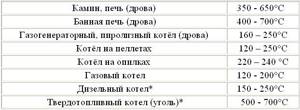
Approximate flue gas temperature (*high sulfur fuel) - corrosion resistance . When some types of fuel burn, vapors of sulfuric and hydrochloric acid are formed, which not every material can withstand. The more sulfur in the fuel, the more resistant to the effects of sulfur compounds the material must be. According to this parameter, chimneys are divided into three classes : the first - for removing gas combustion products, the second - firewood and liquid fuel with a sulfur content of up to 0.2%, the third - for coal, peat, diesel fuel;
- presence of condensate in the chimney;
- gas pressure in the chimney . There are designs designed to work with natural draft, and there are those that are designed to work with pressurized boilers;
- soot fire resistance. The temperature in the chimney when soot ignites, if present, can briefly rise to 10,000C - not every material can withstand this.
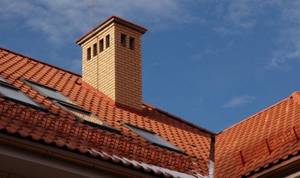
From all this it follows that:
- for wood stoves, solid fuel boilers, sauna stoves and fireplaces, it is necessary to choose a material that can withstand operating temperatures of about 7000C and a short-term increase to 10000C. These are brick and less often ceramic chimneys;
- gas boilers require a chimney that can withstand temperatures of 2000C with a short-term increase to 4000C. Typically, metal pipes are used for these purposes;
- For boilers using liquid fuel and sawdust, a material for the chimney pipe is needed that can easily withstand temperatures up to 2500C with an increase to 4000C, and if we are talking about diesel fuel, then resistant to the aggressive environment of exhaust gases.
Now let's look at the properties of the most popular materials that are used to construct a chimney pipe.
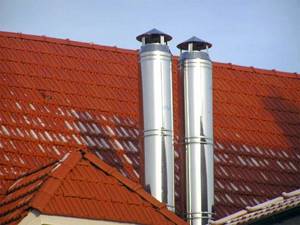
Tips for cleaning chimneys
Unlike chimneys of heating solid fuel stoves, which are cleaned at the beginning of each heating season, sauna pipes are serviced as needed. Practice shows that if you regularly use a steam room, this procedure must be carried out at least 2 times a year.
To remove soot from the inner surface of the flue, it is convenient to use metal or plastic brushes with a metal weight. A rope tied to them allows you to lower the device from top to bottom, cleaning the channel along its entire length.
A brush with a weight for cleaning smoke ducts allows you to clean chimneys of any length
If it is not possible to get to the upper end of the pipe, then a hatch is installed in its lower part. Through it, cleaning is carried out from the bottom up, using the same brush attached to a long steel cable. Condensate from a system with metal pipes is drained using a ball valve, which is mounted at the lowest point of the moisture trap.
The mechanical method, although the most effective, is associated with quite serious labor costs. The process of removing soot can be made easier by using chemicals that are burned in the stove along with firewood.
Video: how to clean a chimney in a bathhouse
https://youtube.com/watch?v=WT3FqN4DLa0
The chimney is a mandatory attribute of a sauna stove, on which the efficiency of its operation depends. Choosing exactly what its design should be is only half the battle.
It is equally important not to forget about SNiP and fire safety standards during the design and installation process. Only in this case will the wish “enjoy your steam” sound like a call for a safe and pleasant pastime
Types of chimneys
Let's figure out which chimney is better for a stove and fireplace, and which one is suitable for a gas boiler.
Brick chimney

Chimney brick for a wood-burning fireplace or stove has been a traditional material since ancient times. But not every brick is suitable for a chimney . Sand-lime brick does not withstand high temperatures very well, so it should not be used for the construction of chimneys.
- You need to know that ceramic brick, which many people use to build ceramic chimneys, is also not a standard. Moreover, not all brands of ceramic bricks are suitable for this.
- It is believed that ceramic bricks can withstand temperatures of 800 °C. But this is not entirely true. Responsible manufacturers indicate this on their products – up to 800 °C.
- This prefix “before” can play a cruel joke on you, because it can be either 650 or 700 °C.
Our advice: to build a chimney for a fireplace, use only special refractory bricks . When purchasing it, carefully read the temperature parameters specified by the manufacturer. A certificate is required.
Advantages of a brick chimney:
- A brick chimney fits perfectly into the interior of any home and is a wonderful addition to the exterior decor of the house.
- The relatively low draft of such chimneys allows them to be used with heating units that run on wood fuel, that is, this is an ideal option for a stove or fireplace.
- Another advantage is the relatively low cost of a brick chimney.
- A brick chimney accumulates heat well.
- Brick chimneys are bulky and heavy.
- When installing them, a mandatory foundation is required.
- The rough surface quickly becomes clogged with soot and requires frequent maintenance.
- The use of other types of fuel or use with modern heating devices leads to the formation of condensation in such chimneys, which destroys the chimney.
- Practice shows that destruction in the chimney occurs within 2–5 years after the start of intensive use.
Advantages and disadvantages of sandwich chimneys
In industrial conditions, stainless steel products are used for the inner layer of the sandwich, and zinc-coated steel pipes are used for the outer layer. In this case, the inner contour is covered with thermal insulation and placed inside the outer cylinder. As a result, such a structure functions quite efficiently and efficiently.
Installing a chimney made from sandwich products does not take much time and effort - all the work can be completed in a day. Below we present a number of advantages and disadvantages of such pipes.
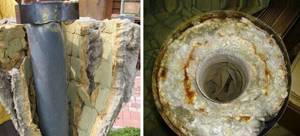
Among the advantages of such structures are:
- multitasking - such pipes can be used in buildings made of any materials;
- occupy a minimum of space;
- ease of transportation;
- Even a beginner in construction can install sandwich pipes, as it is very simple and quick;
- laconic and pleasant appearance;
- fire safety - this is one of the best options for chimneys in this regard;
- the existing roof truss system does not create any obstacles to the installation of a sandwich pipe;
- due to the presence of several layers, much less soot accumulates in such a pipe and almost no condensation forms, so cleaning it is required much less frequently;
- The sandwich pipe is capable of fully protecting residents from the influence of toxic combustion products.

But such designs have very few disadvantages, although they still exist:
- the price of a sandwich pipe is quite significant;
- The optimal service life of such products is only about 15 years.
If you want to make a sandwich pipe with your own hands, then such a chimney will cost you much less than, say, one made of brick. This will result in a completely reliable chimney, and there should be no difficulties with installation and assembly.
Criteria for choosing natural draft flues
When selecting the material for a future chimney, most homeowners focus on the price of the product and the cost of installation. For reliable and safe operation of heating equipment, other factors will have to be taken into account:
- Compatibility of the chimney with the type of boiler. Units with high efficiency (gas, diesel) emit smoke at a temperature of 70...120 °C, brick stoves and solid fuel heat generators - 150...200 °C, steel and cast iron stoves - up to 400 degrees.
- The method of installing a gas duct is internal installation with a passage through the ceilings and roof, or external installation along the wall.
- Combustibility of the material from which the building is constructed.
- The ability to repeatedly withstand an increase in the temperature of exhaust combustion products up to 1000 degrees. Such emergency situations occur when soot accumulated inside the pipe ignites.
- Corrosion resistance, durability.
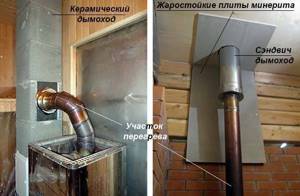
Before choosing a chimney material, decide on the option for laying it and sketch out a diagram. Let us remind you about the requirements for smoke exhaust pipes:
- the diameter (sectional area) of the channel is no less than the outlet of the boiler, stove or fireplace;
- the minimum pipe height is 5 m, calculated from the grate (burner) to the top cut;
- the chimney head should not fall into the wind pressure zone formed behind the ridge of a gable roof or a tall building standing close to it;
- the maximum number of channel turns by 90° is no more than three;
- the indentation of the pipe surface unprotected by insulation from combustible (wooden) building structures is 50 cm, protected – 38 cm;
- the length of the horizontal section connected to the boiler pipe is a maximum of 1 m;
- According to fire safety requirements, all metal gas ducts laid through the rooms and attic of a residential building must be insulated with non-flammable material - basalt or kaolin wool.
The chimney for a stove or boiler must provide stable natural draft and removal of harmful gases to the outside of the room - this is the main requirement
It is equally important to comply with other fire safety standards, for example, not to use corrugated aluminum hoses on heating boilers
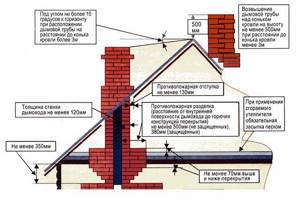
Regulatory requirements for head height and fire clearances
Rules for installing a chimney for a fireplace
It is necessary to install a chimney for a fireplace, taking into account fire safety standards. There are basic recommendations that must be followed during installation:
- The junction of the pipe and the fireplace itself must be completely sealed. This determines where the smoke will go during the combustion process. The diameter of the pipe should not exceed the diameter of the fireplace inlet pipe. If this principle is not observed, there is a danger of carbon dioxide entering the room.
- The place where the fireplace pipe passes through the house must be isolated from finishing materials. Materials such as asbestos cement, basalt wool and sheet metal are used as fire protection. The distance from flammable materials must be at least 13 cm for a multi-layer pipe and at least 24 cm for a single-layer pipe. For brick pipes, it is necessary to use a thicker type of masonry and additional asbestos-cement insulation at the joints with the finishing of the house.
- It is advisable to install the chimney strictly vertically. No more than three bends in the design are allowed. If there is a need for horizontal installation of the pipe, such a section should occupy less than one meter. Otherwise, the air draft from the fireplace is disrupted.
- The size of the pipe affects the draft force in the chimney. The minimum height from the combustion source to the tip is 5 meters.
- The chimney should protrude at least 50 cm above the roof roof. If the roof is sloping, you should focus on the highest point.
- The distance between the chimney head and the ridge should be about 50 cm. If the pipe is routed through a wall, a minimum height from the ground of one meter must be maintained.
- To prevent condensation from collecting inside the pipe, and to ensure optimal draft, it is advisable to install the fireplace pipe near the inside wall of the house, rather than leading it outside. The material from which the chimney is made will also last longer, as it will not be influenced by the external environment.
Thanks to these recommendations, the installation of the pipe will be carried out as safely as possible, and will also create good air draft in the chimney.
Disadvantages of brick chimney pipes
Like most materials, a brick chimney for a fireplace also has some disadvantages. One of them is a short service life (7 – 10 years). In addition, temperature changes in winter will inevitably lead to the formation of condensation on such pipes, which, after numerous freezing and thawing, will cause destruction of the brick chimney masonry.
However, the impact of this negative factor can be significantly reduced by using one of the following actions:
- increase the cross-section of the chimney for the fireplace, or rather, its external walls to 25 centimeters in those areas that are above the roof;
- insulate this sector of the pipe with mineral wool.
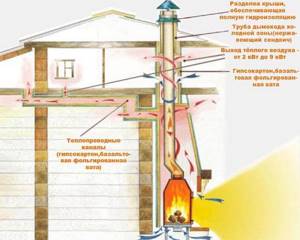
Another disadvantage of a brick chimney is a large number of irregularities on its inside. In this case, the draft efficiency is significantly reduced, which cannot be said about chimneys with a smooth inner surface. To avoid such a problem, even at the design stage, the chimney should be provided with a certain cross-sectional reserve.
When installing fireplaces and chimneys, the use of galvanized steel chimney pipes mounted inside will also increase the service life.
Stainless steel chimneys for fireplaces
These pipes are assembled elements made of stainless steel, and their thermal insulation is carried out using flammable materials.

Chimneys of this type can have different diameters and lengths. The kit often includes ceramic pipes that are mounted inside steel pipes.
A galvanized steel chimney has a number of advantages:
- due to their light weight, sandwich chimneys for fireplaces can be installed without a foundation (read: “Sandwich pipes for a chimney - installation”);
- such a chimney can be installed even after the entire construction process is completed;
- a stainless steel chimney pipe is cheaper than block and ceramic chimneys;
- Individual parts of the chimney can be easily replaced if desired.
Information with photos on installing chimney pipes made of stainless steel can be found on our website if desired.
You cannot use a sandwich for a fireplace chimney.
To prevent the draft from overturning during the cold period, do not use a “sandwich” as a fireplace chimney. If you use it as a fire safety element when passing inside the house, then at least do not place the “sandwich” above the roof, leave it warm, within the house, and make the street part of the chimney out of brick with a cross-section as close as possible to the internal diameter .
If this is not possible, do as our ancestors did. They made the chimney pipe ceramic and filled it (coated it) along the contour with a heat-intensive material, in particular lime mortar.
In order to minimize the risk of draft overturning, the chimney must very slowly release the heat it has gained. That is, it must have greater thermal inertia. “Sandwich” does not have this quality, and therefore cannot be considered a “warm” pipe.
Block ceramic chimneys
Thus, the installation of fireplaces and chimneys is sometimes carried out using special block ceramic pipes. Technical characteristics of block ceramic chimneys. The ventilation channels of these chimneys are represented by blocks made of light weight concrete. Today there is a wide selection of samples, and everyone can choose the one they need in terms of height and size.
These blocks are connected using vertical reinforcement, and a ceramic pipe and thermal insulation made of non-combustible materials are placed inside. There may be several options for making a ceramic pipe; it all depends on the manufacturer, who recommends applying one or another technology to a specific sample. Therefore, there is no single device system.
Building a chimney for a barbecue
In a country house, the question may arise with the construction, choice of materials and size for the chimney not only for the fireplace, but also for the barbecue. The construction of a chimney must be thought out; the first stage will always be a drawing of its plan on paper.
Important! You can start building a chimney for a barbecue only after the solution of the main part of the structure has completely hardened.
The simplest solution for building a chimney for a barbecue is to use cement mortar and reinforcing metal bars. The chimney frame is bent and then welded from metal rods. The metal frame is cemented and wrapped in mesh. The solution is applied to the rods from the inside and outside. After the cement mortar has hardened, the chimney is coated from the inside with refractory clay. The arch is formed after the solution hardens in the chimney; it requires a plywood template.
The drying time for the cement mortar used in the construction of a barbecue and a chimney for it is 3-4 days. Until this time, you cannot light a fire in the firebox, otherwise the walls of the structure will crack and the barbecue will be unsuitable for further use.
The question of how to make a chimney for a fireplace is decided with mandatory consideration of all technology and safety requirements. If they are violated, not only the efficiency of the fireplace is at risk, but also the livelihoods of all people in the heated room. Therefore, the best option for those who do not have proper experience in constructing such structures is to contact specialists proven in this matter.
Advantages and disadvantages of ceramic chimneys for fireplaces
The advantages of a ceramic pipe include the following characteristics:
- the material is very quick to install and assemble;
- is a guarantee of high efficiency;
- long service life;
- the range of blocks is large, which makes it possible to mount a chimney opening with any configuration;
- the presence of a special hole that makes it possible to clean the chimney;
- the condensate that appears drains away thanks to the hole located at the bottom of the chimney.

Among the disadvantages of block ceramic pipe systems, it is customary to highlight the following:
- relatively high price;
- Due to the fact that most of these chimneys are manufactured abroad, the delivery time is sometimes very long.
Design features of the chimney
The purpose of the fireplace chimney, as well as the main function of the chimneys of stoves or boilers, is to discharge fuel combustion products out into the atmosphere. Gases along with soot flow from the furnace into the chimney under the influence of draft.
The correct formation of a chimney consists in choosing and constructing a structure in which a minimum of soot remains on the walls of the pipe, and the draft prevents the flow of gases into the room.
Chimneys made of different materials have their own characteristics and may differ in design. For example, a traditional brick chimney consists of the following parts.

Modern chimneys made of steel or ceramics do not have such fragments as otter or fluff, but for the normal removal of smoke in brick pipes and to protect the ceilings from heating, they are simply necessary
When choosing a material, it is necessary to take into account the temperature of the gases: in the furnace it is higher, at the outlet it is lower, but even at the highest point it can reach +100 ° C. The creation of draft is based on the temperature difference - hot air is replaced by cold air.
Also important are indicators such as the height and internal diameter of the chimney - they are calculated when drawing up the project.
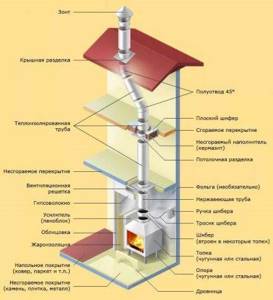
A variant of a fireplace design with a chimney made of a steel pipe. Features: floor and wall cladding with non-combustible materials, finishing of floors, possibility of creating non-vertical sections using half-bends
No matter how hard you try, it is impossible to build a chimney that does not need cleaning. Even in a properly assembled ceramic chimney, soot accumulates over time, making it difficult for gases to escape. Therefore, chimney cleaning must be carried out regularly. This is usually done during the period when the fireplace is idle.
In addition, it is necessary to monitor the integrity of the connections and the internal surface: cracks, potholes or protrusions that may appear over time prevent the normal circulation of hot air.
Placement methods ↑
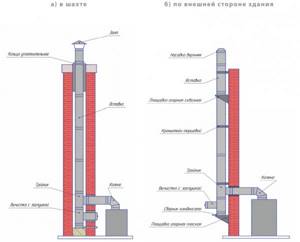
The connection of fireplace chimneys to the heating device is carried out only after their final installation in a pre-calculated place. Typically, this location is selected taking into account the design features of the living space, which ensure the possibility of laying the chimney in an area that is convenient and safe for the removal of hot gases.
Important The choice of a specific area for the chimney is carried out even before the installation of combustion equipment.
It is also necessary to take into account that chimneys for the fireplace can be placed both indoors and on the outside (photo on the right).
When located internally, the channel is installed within the boundaries of a heated building or room. In our country, they traditionally do exactly this, installing fireplace chimneys directly in the house and leading their end out through a special hole in the roof.
Placing most of the outlet channel inside the building allows not only to protect it from freezing, but also to significantly reduce heat losses due to limited contact with cold air. With this arrangement of combustion product removal routes, the smoke rising through the pipe gradually cools, due to which the possibility of condensation formation is noticeably reduced.
However, this position of the fireplace chimney has one significant drawback, which is that the structure itself takes up too much space. In addition, with this arrangement, the risks of accidental fire from contact with the walls of a heated channel increase.

When the outlet pipe is in an external position (photo above), only the fireplace takes up space in the room, which is essential for small rooms. In addition, the likelihood of fire hazards is reduced, since the hot walls of the chimney are in contact not with the elements of the interior decoration, but with open space.
Before the advent of modern thermal insulation materials, this installation method was rarely used in construction practice, since it was not at all easy to reliably insulate an open fireplace pipe in severe frosts. With the development of sandwich technologies by our industry, it became possible to equip open chimneys (usually in private houses and country cottages).
However, for all the advantages of the open method of laying a sandwich pipe for a fireplace, you have to pay a decent amount of money spent on reliable thermal insulation of the outlet channel located in the open air.
Calculation example
For example, there is a house of 60 sq. meters. On average, heat loss is 100 W/sq.m., the required heat flow is 6000 W. We apply a safety factor of 1.2 - 6000 * 1.2 = 7200 W In the table, the maximum approximate value will be 7185 W at a flow speed of 0.5 m/s. In the leftmost column, the internal diameter of the pipe will be 15 mm. Using the manufacturer's table, we find the required outer diameter of the pipe. For example, for the closest value in the direction of increase - 18 mm. This is a universal multilayer pipe (PE-Xc\Al\PE) 25 mm. We look the same way. A 25 mm Stabi polypropylene pipe is suitable for us.
Principle of operation
During operation of the heating system, gases are released. They are hot, therefore dense, and rise into the smoke channel. When gases rise through the pipe, a reduced pressure is created inside it, drawing in cold air from the environment. Thus, combustion products are pushed out and discharged through the pipe. The air above the chimney is cold and has a different density compared to smoke. This difference allows smoke to escape easily from the stove or fireplace. This outgoing flow is called upward.
To ensure normal operation, it is important to consider the height of the chimney. If it is calculated incorrectly, the upward flow will slow down its movement or, conversely, accelerate it (if the pipe is too high or too small). Result: the overall heating of the room decreases, smoke begins to flow inside. If the design calculations are severely violated, reverse draft extinguishes the fire.
Device
Installing a chimney for stoves or fireplaces requires installers to know the norms for the permissible elevation of the pipe above the building. It should be located at a level of one and a half meters from the ridge of the roof and above. You cannot place the pipe below a line drawn from the ridge down at an angle of 10 degrees, if the pipe is located at a distance from the ridge of more than 3 meters. If the chimney is located at a distance of one and a half meters, then the pipe should not be below the horizontal line of the ridge. If the channel is located close to the ridge, at a distance of up to one and a half meters, then it should not be lower than its level (a deviation of 0.5 m is allowed).
You cannot install a smoke exhaust duct with ventilation pipes under one system. In this case, combustion products will be drawn into the ventilation system. This can be avoided by raising the furnace outlet above the ventilation system.
The chimney device involves installing a straight vertical pipe. If necessary, make turns. They are performed using special inclined elements at an angle of 45 degrees. The sum of the lengths of all inclined elements, regardless of the height of the chimney for stoves and fireplaces, should not exceed two meters. The minimum height is 5 meters.
Possible problems with the operation of the fireplace pipe
The operation of a fireplace largely depends on the correct installation of the chimney. If insufficient draft occurs, you should check the calculations according to which the chimney was built.
The fireplace pipe is installed incorrectly if:
- smoke enters the room;
- lighting a fireplace takes a long time;
- the fire in the fireplace burns too low;
- The burning intensity of solid fuels varies constantly and depends on weather conditions.
The first step when these problems occur is to ensure proper ventilation in the room. It is necessary to check the tightness of the windows and the intensity of the ventilation, if any. Since the fireplace flame burns most of the oxygen, there must be a constant flow of fresh air into the house.
The reasons for the chimney not working properly are as follows:
- Insufficient pipe height. The larger the fireplace, the higher the duct must be to provide sufficiently strong draft.
- The pipe design contains bends of more than 45 degrees. It is advisable to make the chimney as straight as possible. If there are still horizontal elements, you should choose the minimum angle of inclination. The vertical part must be at least 5 meters.
- Incorrect calculations. The draft largely depends on the correct cross-section of the chimney.
- External influence. Weather conditions can affect the intensity of draft in the pipe. To prevent this from happening, it is necessary to install a weather vane on the chimney.
The chimney pipe for the fireplace must be installed in accordance with all standards. This will make the fireplace fireproof and also ensure its proper operation.
Requirements for chimneys
The key requirement for a chimney installation is the correct choice of pipe cross-section and height. Another important condition is the strictly vertical location of the pipe and its reliable sealing, and, if necessary, thermal insulation when installed next to a load-bearing wall.
The requirements for the design of the chimney apply to both its internal part and the external part (the one where the pipe is located above the roof surface).
The following requirements are imposed on the internal part of the structure:
- the pipe material must be resistant to high temperatures and corrosion;
- the design must be strictly sealed in relation to exhaust gases and combustion products;
- the pipe can only be connected to one fireplace or stove equipment (it is prohibited to cut an exhaust ventilation outlet into it, etc.);
- the internal cross-section of the chimney must be constant, without contractions or expansions;
- the diameter of the chimney pipe must be equal to the cross-section of the chimney pipe of the fireplace insert;
- the minimum chimney height is 3.5-5 meters (depending on the height of the building).
Attention! The optimal cross-sectional shape of the chimney is round. A rectangular or square chimney must have rounded corners with a radius of 2 cm and a maximum aspect ratio of 1.5.
For the outer part of the structure, the requirements are as follows:
- It is advisable to install the chimney pipe outlet above the roof at the level of the ridge or next to it;
- the height of the outer part of the pipe should not be less than 50 cm;
- if the distance from the ridge to the chimney is more than 1.5 m, then the height of the pipe should be equal to the height of the roof ridge.
We recommend that you read: PVC pipe for protecting electrical wiring
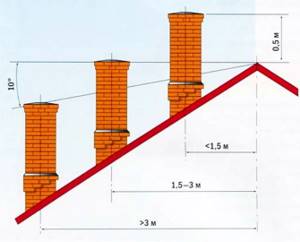
Reference. The ridge is the horizontal line of a gable roof along which two parts of the roof are connected, i.e. the highest point of the building.
Diameter
In order to calculate all the parameters, it is now necessary to decide on the material that will be used in the construction process. It is most convenient to carry out the calculation on paper, creating a sketch of the future structure; it is necessary to take into account some nuances:
- The diameter of the chimney for a fireplace must have a certain relationship with the firebox. Calculating this value has its own subtleties. For example, when calculating the diameter of a pipe that connects to an open firebox structure, a proportion of 1:10 is used. This method is only correct for a cylindrical type of chimney.
- The calculation of the cross-section for a square type device contains proportions of 1:15. But the diameter should be smaller than the size of the blower. If the resulting heat transfer is less than 300 cal/hour, the cross-section should not be less than 140 x 140.
- In order to determine the optimal diameter of the fireplace chimney, you can take as a basis state standards, which stipulate the permissible cross-section under certain conditions.
- In addition, the height and diameter are calculated in accordance with the area of the room.

Standard dimensions of internal diameters and cross-sectional areas of brick chimneys
It would be a good idea to show your calculation to specialists and analyze it together. In addition, a suitable calculation scheme can be posted on the Internet.
It must be remembered that the calculation of these parameters must be done correctly; the efficiency of the heating device depends on this.
Rules for installing a chimney through a wall with your own hands
Smoke removal will be effective if you follow the basic rules:
- For good traction, you need to raise the pipe above the ridge.
- With a long part of the chimney (more than 10 m), the fuel will quickly burn out; with a short part (less than 5 m), there will be no intense combustion.
What is the best way to route the pipe from the stove through the wall, experts say. The main stages of installing a smoke exhaust system are indicated in the step-by-step instructions.
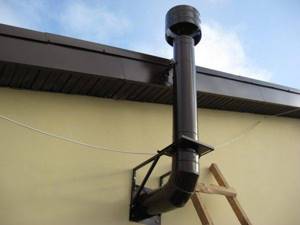
For good traction, you need to raise the pipe above the ridge.
Sandwich chimney installation diagram
Installation of a chimney made of sandwich pipes through a wall is carried out in accordance with the following standards:
- Indoors without condensate drainage;
- From the outside - “through condensation”, the resulting moisture flows into the drainage cup.
The scheme is selected for a specific room, taking into account the interior design. You can install a sandwich chimney with a passage through the wall yourself.
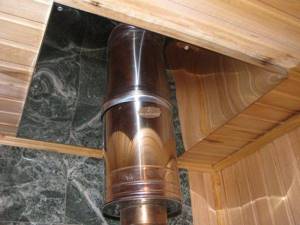
The scheme is selected for a specific room, taking into account the interior design.
Preparatory stage
Before installing the heat generator, insulate the base with cement or heat-resistant metal. All components are assembled; the sandwich system consists of many elements; it is necessary to prepare a complete sandwich set. Swivel fittings will be required to form the elbows. They buy insulation with a reserve. It is recommended to lay a foil layer to the inner contour. You will need hardware to install fasteners. The joints are fixed with clamps.
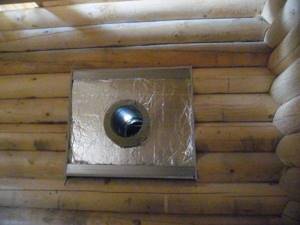
It is recommended to lay a foil layer to the inner contour.
Basic installation steps
After determining the location of the pipe, heating equipment is installed. Then a hole is made in the wall slightly larger than the outer diameter of the sandwich. A connecting pipe is mounted, the chimney is connected to the heating equipment through a tee. At the last stage, the outer part of the flue is attached to the outer wall of the building in increments of at least 50 cm.

At the last stage, the outer part of the flue is attached to the outer wall of the building in increments of at least 50 cm.
How to remove soot
It will be safe and comfortable to have a fireplace in the house only if there is good draft in the chimney. And this largely depends on his condition.
There are several cleaning methods for chimneys: there are traditional ones, which people have used for centuries, and modern ones, based on scientific developments. These methods include:
People's
In the old days, chimneys were cleaned with aspen wood, which could generate heat in the firebox up to 1200C. Under such influence, the soot becomes loose and burns, and everything that remains of it flies out along with the smoke into the chimney.
Before cleaning using this method, you must be sure that such high temperatures will not harm your chimney, since it will be difficult to avoid destruction or fire if the chimney, for example, cracks.
Even in the old days, they used another method of cleaning the chimney: they burned dried potato peelings, the combustion of which released substances that could loosen the soot, and then it was easily removed from the cleaning holes. But traditional methods will not always help, and in case of severe blockage it is better to turn to chemistry.
Chemical
Today, you can find a variety of cleaning products for cleaning chimneys in the stove store. It can be powder, tablets, liquid or special pellets, logs and briquettes, which are simply placed in the firebox (with or without firewood) and burned. More details about the use of each chemical are described in the instructions supplied with them.
Cleaning briquettes are considered the most convenient of all chimney cleaning chemicals. They heat the fireplace for about two hours, due to which the substances that bind the soot in the chimney are destroyed, and the remaining fines are carried out, like the smoke, into the chimney.
If there was a large blockage in the pipe, it will fall down, and therefore, after servicing the chimney, an inspection of the entire chimney space is necessary, for which there are special doors.
